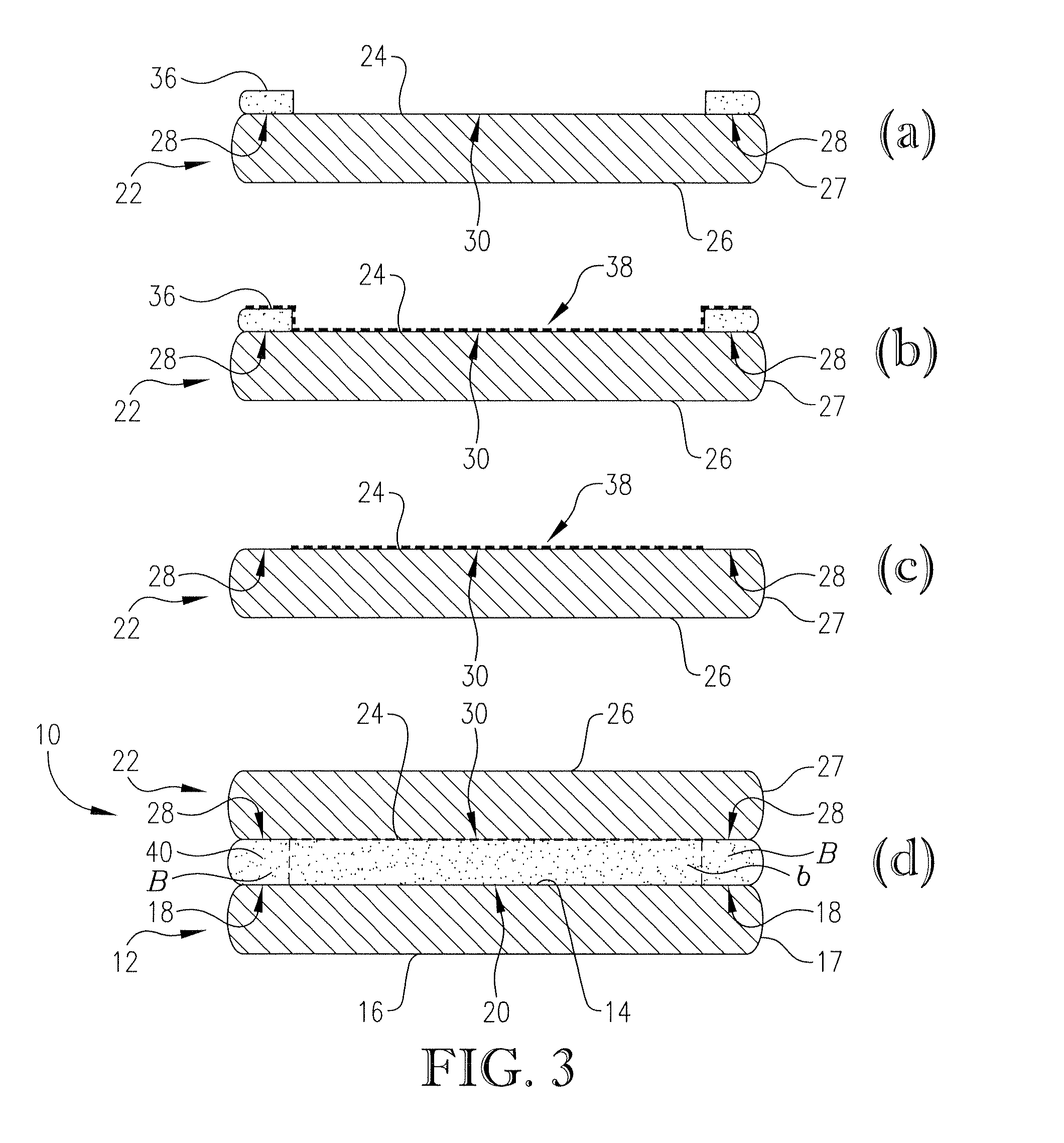Method and apparatus for removing a reversibly mounted device wafer from a carrier substrate
a technology of carrier substrate and device wafer, which is applied in the direction of grinding feeders, manufacturing tools, lapping machines, etc., can solve the problems of high thermal and mechanical stress on the device wafer, the inability to form backside electrical contacts that connect with the front-side circuitry, and the thinned device wafers that have been less than 100 microns thinned to less than 60 microns
- Summary
- Abstract
- Description
- Claims
- Application Information
AI Technical Summary
Benefits of technology
Problems solved by technology
Method used
Image
Examples
example 1
Separation of Edge-Bonded Wafers Having Modified Center Surface Using Hand-Operated Peeler with Removal of Bonding Material from the Outer Edge
[0100]In this procedure, a wafer stack is prepared according to a method of the invention and then separated using a hand-operated peel separator. Prior to adhering the two wafers together, the center contact surface of one wafer is chemically modified using a fluorinated silane solution to create an adhesive strength differential across the wafer surface. A bonding material (WaferBOND® HT10.10, available from Brewer Science, Inc., Rolla, Mo.) was dispensed onto the surface of a 200-mm silicon wafer (wafer 1) at the outer edge to form a very thin coating around the peripheral region of the wafer surface that was about 2.5 mm wide by approximately 0.5 μm thick. A surface-modifying composition was formed by diluting a fluorinated silane ((heptadecafluoro-1,1,2,2-tetrahydradecyl) trichlorosilane; Gelest Inc., Morrisville, Pa.) to a 1% solution u...
example 2
Separation of Adhered Wafer Stack Using Hand-Operated Peel Separator
[0104]In this procedure, a wafer stack is prepared according to another method of the invention and then separated using a hand-operated peel separator. Prior to adhering the two wafers together, the center surface of one silicon wafer is chemically modified using a fluorinated silane solution to create an adhesive strength differential across the wafer surface. To modify the center surface of the wafer, the edge of the wafer was first masked using a coating of an epoxy-based photoresist (SU-8 2002, Microchem, Newton, Mass.). The photoresist composition was dispensed onto the outer edge surface of a 200-mm silicon wafer (wafer 1) to coat a peripheral ring-shaped section of the wafer surface that was about 2.5 mm wide.
[0105]Next, a fluorinated silane ((hepta-decafluoro-1,1,2,2-tetrahydradecyl)trichlorosilane; Gelest, Morrisville, Pa.) was diluted to a 1% solution using FC-40 solvent (perfluoro-alkyl compound with pri...
example 3
Hand-Operated Peel Separator Used to Separate Wafer Stack with Center Contact Surface Coated with Release Material
[0108]In this procedure, a wafer stack is prepared according to another method of the invention and then again separated using a hand-operated peel separator. Prior to adhering the two wafers together, the center surface of one wafer is coated with a release material to create an adhesive strength differential across the wafer surface-center layer interface. First, a negative epoxy-based photoresist (sold under the name SU-8 2010; obtained from MicroChem) was spin coated onto the entire surface of a 200-mm glass wafer (wafer 1), followed by baking at 110° C. for 2 minutes to effect solvent removal. A Teflon® AF solution (Teflon® AF2400 in FC-40; obtained from DuPont) was then spin coated over the photoresist layer to create a nonstick layer. Next, FC-40 solvent was dispensed onto the surface of the wafer at the outer edge to remove about a 1-3 mm wide section of the Tefl...
PUM
| Property | Measurement | Unit |
|---|---|---|
| Thickness | aaaaa | aaaaa |
| Thickness | aaaaa | aaaaa |
| Angle | aaaaa | aaaaa |
Abstract
Description
Claims
Application Information
 Login to View More
Login to View More - R&D
- Intellectual Property
- Life Sciences
- Materials
- Tech Scout
- Unparalleled Data Quality
- Higher Quality Content
- 60% Fewer Hallucinations
Browse by: Latest US Patents, China's latest patents, Technical Efficacy Thesaurus, Application Domain, Technology Topic, Popular Technical Reports.
© 2025 PatSnap. All rights reserved.Legal|Privacy policy|Modern Slavery Act Transparency Statement|Sitemap|About US| Contact US: help@patsnap.com



